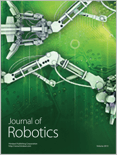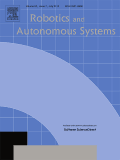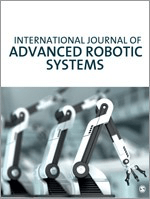
Journal of Robotics
Scope & Guideline
Exploring the Frontiers of Robotic Engineering
Introduction
Aims and Scopes
- Robotic Control Systems:
Research on various control strategies for robotic systems, including trajectory tracking, adaptive controls, and robust control algorithms, aimed at enhancing the precision and efficiency of robotic operations. - Path Planning and Navigation:
Development of algorithms and methodologies for effective path planning and navigation of robots in complex environments, ensuring optimal routes and obstacle avoidance. - Collaborative and Service Robotics:
Exploration of collaborative robots (cobots) and their integration into industrial processes and service roles, focusing on human-robot interaction and shared workspace dynamics. - Soft Robotics and Rehabilitation Technologies:
Investigation into soft robotics, particularly in applications for rehabilitation and movement assistance, emphasizing the design of flexible and adaptive robotic systems. - Machine Learning and AI in Robotics:
Utilization of machine learning and artificial intelligence techniques to improve robotic functionalities, including perception, decision-making, and automation. - Multimodal Sensing and Localization:
Research on sensor technologies and localization methods for robots, including visual SLAM and sensor fusion, to enhance situational awareness and operational capabilities. - Robotic Applications in Various Industries:
Application-oriented research that demonstrates robotics' impact across sectors such as manufacturing, healthcare, and logistics, showcasing innovative solutions to industry-specific challenges.
Trending and Emerging
- Collaborative Robotics and Human-Robot Interaction:
An increasing number of studies focus on collaborative robots (cobots) designed to work alongside humans, highlighting the importance of interface design, safety protocols, and shared task efficiency. - Autonomous Systems and AI Integration:
There is a marked trend towards integrating artificial intelligence with autonomous robotic systems, enhancing their decision-making capabilities and adaptability in dynamic environments. - Robotics for Environmental Monitoring and Sustainability:
Emerging themes include the use of robotics in environmental applications, such as monitoring ecosystems, disaster response, and sustainable practices, reflecting a growing concern for ecological impacts. - Soft Robotics and Bioinspired Designs:
Research in soft robotics is gaining traction, focusing on robots that mimic biological systems for applications in rehabilitation, dexterity, and interaction with fragile environments. - Advanced Sensor Technologies and SLAM:
The development and application of advanced sensor technologies for simultaneous localization and mapping (SLAM) are trending, enabling robots to navigate complex environments with greater accuracy. - Multi-Robot Systems and Coordination:
Research exploring the coordination and collaboration of multiple robotic systems is on the rise, addressing challenges in logistics, surveillance, and search-and-rescue operations.
Declining or Waning
- Traditional Industrial Robotics:
There has been a noticeable decrease in research centered on traditional industrial robotics, such as fixed automation systems, as the field shifts towards more flexible and collaborative robotic solutions. - Basic Robotics Theory and Fundamentals:
Papers focusing on foundational theories and basic principles of robotics are less frequent, indicating a potential shift towards applied research and practical implementations. - Robotics in Non-Technical Domains:
Research exploring the application of robotics in non-technical fields, such as social sciences or humanities, appears to be waning, possibly due to a growing emphasis on technical innovations and applications. - Low-Cost Robotics Solutions:
Interest in low-cost robotic solutions has diminished, likely as the industry moves towards more sophisticated, high-performance robotics that leverage advanced technologies.
Similar Journals

Cyborg and Bionic Systems
Advancing the Future of Human-Machine IntegrationCyborg and Bionic Systems, published by the American Association for the Advancement of Science, stands as a pivotal open access journal that has enriched the academic landscape since its inception in 2020. With an E-ISSN of 2692-7632, this journal focuses on interdisciplinary research that converges on advances in Artificial Intelligence, Biomedical Engineering, Human-Computer Interaction, and Mechanical Engineering. Notably, the journal has attained impressive rankings, securing Q1 status across these categories and exhibiting a commendable Scopus ranking with percentile standouts in each discipline, thus establishing its influence and relevance in the scientific community. Based in Washington, DC, this journal provides a platform for innovative ideas and findings that aim to enhance our understanding of cyborg systems and bionic devices. The open access model ensures that groundbreaking research is readily available to researchers, professionals, and students alike, fostering collaboration and knowledge dissemination within these rapidly evolving fields.

Frontiers in Robotics and AI
Shaping Tomorrow's Technologies with Cutting-Edge ResearchFrontiers in Robotics and AI is a leading journal dedicated to the exploration and dissemination of groundbreaking research in the fields of robotics and artificial intelligence. Published by FRONTIERS MEDIA SA in Switzerland, it has established itself as a vital resource for academics, professionals, and students since its inception in 2014. With an impressive Open Access model, the journal ensures that high-quality research is accessible to a global audience, fostering collaboration and innovation. The journal is recognized for its distinguished impact in the academic community, achieving Q2 quartile rankings in both Artificial Intelligence and Computer Science Applications as of 2023. It currently holds a solid position in Scopus rankings, with a rank of #123 out of 350 in Artificial Intelligence and #223 out of 817 in Computer Science Applications, reflecting its robust contribution to these dynamic disciplines. The journal's scope encompasses a wide range of topics, including but not limited to autonomous systems, machine learning, and human-robot interaction, making it an essential platform for innovative ideas and advanced research.

ROBOTICS AND AUTONOMOUS SYSTEMS
Shaping the Landscape of Robotics and Automation.ROBOTICS AND AUTONOMOUS SYSTEMS, published by Elsevier, is a leading journal in the fields of robotics and automation, providing a platform for the dissemination of high-quality, peer-reviewed research. With an impressive impact factor and a prestigious reputation, this journal is classified in the Q1 category for major fields including Computer Science Applications, Control and Systems Engineering, Mathematics, and Software as of 2023. The journal boasts an extensive archive dating back to 1988, reflecting the evolution of the discipline and fostering innovative research discussions that are crucial for advancements in autonomous technologies. Researchers, professionals, and students are encouraged to contribute to and benefit from the ongoing dialogue within these dynamic fields. Accessible through various academic resources, ROBOTICS AND AUTONOMOUS SYSTEMS stands as a pivotal information source for those dedicated to exploring the frontiers of intelligent systems.

Annual Review of Control Robotics and Autonomous Systems
Exploring Interdisciplinary Solutions for Tomorrow's ChallengesAnnual Review of Control Robotics and Autonomous Systems, published by ANNUAL REVIEWS, is a premier, peer-reviewed journal dedicated to advancing the field of control, robotics, and autonomous systems. With its E-ISSN of 2573-5144, the journal is recognized for its high-caliber contributions, evidenced by its Q1 ranking in key categories, including Artificial Intelligence, Control and Systems Engineering, and Human-Computer Interaction. Spanning converged years from 2018 to 2024, it serves as an essential resource for researchers, professionals, and students who seek to stay abreast of the latest developments and methodologies impacting these rapidly evolving fields. The journal does not currently offer Open Access options, which enables it to maintain stringent quality control while ensuring that every issue is packed with scholarly articles that meet the highest academic standards. With a focus on interdisciplinary approaches and cutting-edge technologies, the Annual Review of Control Robotics and Autonomous Systems is poised as a critical voice for scholarly discourse, fostering innovation and collaboration in tackling complex challenges of the modern world.

International Journal of Advanced Robotic Systems
Elevating Robotics Research for a New EraThe International Journal of Advanced Robotic Systems is a premier academic journal, published by SAGE Publications Inc., dedicated to fostering innovation and research in the rapidly evolving field of robotics. With an ISSN of 1729-8814, this Open Access journal has been providing unrestricted access to cutting-edge research since 2004, making it an invaluable resource for researchers, professionals, and students alike. The journal aims to disseminate high-quality, peer-reviewed articles that cover a wide range of topics, including but not limited to robotic systems, automation, artificial intelligence, and sensor technologies. By promoting interdisciplinary collaboration and encouraging novel approaches, the International Journal of Advanced Robotic Systems plays a crucial role in advancing the frontiers of robotics and ensuring its impactful application across various industries. Engaging with this journal not only keeps you at the forefront of the latest developments but also contributes to the global discourse on robotics and its advancements in science and technology.

Intelligent Service Robotics
Empowering Research: Driving the Evolution of Robotics and AIIntelligent Service Robotics, published by SPRINGER HEIDELBERG, is a leading journal that focuses on the transformative intersection of intelligent systems and robotics, establishing itself as a pivotal resource for researchers, professionals, and students in the fields of Artificial Intelligence, Computational Mechanics, and Mechanical Engineering. With an impressive impact factor reflective of its relevance—featuring a 2023 Q1 ranking in Computational Mechanics and Mechanical Engineering, and Q2 in Artificial Intelligence—this journal disseminates high-quality, peer-reviewed research that propels innovation and application in various engineering disciplines. Operating from its headquarters in Heidelberg, Germany, Intelligent Service Robotics aims to foster a dynamic academic community, encouraging open dialogue and collaboration among thought leaders and emerging scholars alike. The journal invites submissions that provide novel insights and solutions in the rapidly evolving landscape of service robotics, ensuring that it remains at the forefront of scientific discourse. With a converged publication timeline from 2008 to 2024 and robust Scopus rankings, the journal is committed to shaping the future of robotic intelligence and its applications.

ROBOTICA
Exploring the Nexus of Technology and IntelligenceROBOTICA is a premier academic journal that serves as a vital resource within the multidisciplinary field of robotics and artificial intelligence. Published by Cambridge University Press, this journal boasts a comprehensive scope that encompasses areas such as computational mechanics, computer vision, control systems, and software applications. With an impressive range of quartile rankings in 2023, including Q2 in key categories like Computational Mechanics and Control and Optimization, ROBOTICA represents a significant contribution to its field, providing researchers and practitioners with cutting-edge insights and advancements. Although it follows a traditional subscription model, the journal maintains a commitment to accessibility through its esteemed indexing performance and robust academic standing, evidenced by Scopus rankings within the top percentiles across multiple relevant disciplines. Covering an expansive period from 1983 to 2024, ROBOTICA is essential for anyone looking to stay at the forefront of robotics research and innovation.

Advanced Intelligent Systems
Connecting Minds, Shaping Intelligent Futures.Advanced Intelligent Systems, published by WILEY, stands as a prominent Open Access journal dedicated to the interdisciplinary exploration of intelligent systems, with a focus on materials science, engineering, and computer science. Since its establishment, the journal has fostered innovative research, providing a platform for the dissemination of findings that push the boundaries of artificial intelligence, human-computer interaction, and systems engineering. Although it is relatively new, having converged from 2023 to 2024, it ranks within various Scopus categories, showcasing its growing influence in fields such as mechanical engineering and computer vision. With an emphasis on accessibility, the journal has been Open Access since 2019, ensuring that cutting-edge research is available to a global audience of researchers, professionals, and students, thus driving forward the frontiers of intelligent systems development.

INTERNATIONAL JOURNAL OF ROBOTICS & AUTOMATION
Navigating the Frontiers of Robotics and Automation.International Journal of Robotics & Automation is a premier academic journal published by ACTA PRESS, dedicated to advancing knowledge and applications in the dynamic fields of robotics, automation, and related engineering disciplines. With a history spanning from 1995 to 2024, this journal serves as a crucial platform for the dissemination of innovative research, offering valuable insights across various categories, including Artificial Intelligence, Control and Systems Engineering, and Mechanical Engineering. Although currently not open access, its rigorous peer-reviewed articles hold significance for researchers, professionals, and students alike, providing a solid foundation for advancements in technology and engineering methodologies. The journal's rankings in Scopus reflect its growing impact, particularly in niche areas of Modeling and Simulation and Software, highlighting the critical need for cutting-edge research and discussion in these developing fields. As the landscape of robotics and automation continues to evolve, this journal remains an essential resource for those seeking to contribute to and engage with the forefront of scholarly research.

ADVANCED ROBOTICS
Driving Excellence in Robotic SolutionsADVANCED ROBOTICS is a premier journal published by Taylor & Francis Ltd that has been at the forefront of robotics research since its inception in 1986. With an esteemed ISSN of 0169-1864 and E-ISSN of 1568-5535, this journal offers a unique platform for disseminating high-quality research across diverse domains within the robotics field, encompassing applications in Computer Science, Control and Systems Engineering, Hardware and Architecture. Ranked in the Q2 quartile across multiple categories in 2023, ADVANCED ROBOTICS maintains a reputable standing in the academic community, emphasizing its commitment to advancing knowledge and innovation. Although not an Open Access publication, the journal’s access options ensure that subscribers can explore the latest findings and engage with prominent experts in the field, facilitating an enriching exchange of ideas. Researchers, professionals, and students alike will find ADVANCED ROBOTICS an invaluable resource for keeping abreast of developments and contributing to the ever-evolving landscape of robotics.